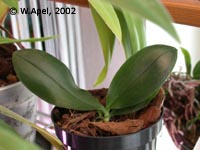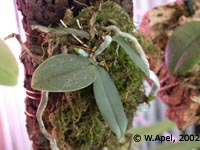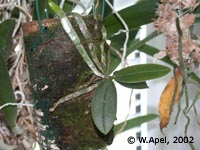Now I want to offer You some hints about the culture of the various species
The species of the section P. grow well either in a pot or being mounted. The mounted kind of culture comes very close to their natural way of life. But consider that the plants tend to dry out quicker than kept in a pot therefore the mounted form attracts a little bit more of one’s attention.
When visiting one of my favourite orchid-gardeners I got in contact with a new method of cultivation namely fixed on special pot which is of clay and you put water in it. The plants are fastened upon the pot’s surface and these I’ve seen were throughout in a very good and growing status. One takes moss fixing them upon the pot in which a slight water-level is always kept guaranteeing a permanent evaporation outside through the pot’s clay-material which evokes a special atmosphere surrounding the fastened plant. Due to this the surroundings show a very high humidity but till now it’s not clear as far this is really necessary for cultivating the plants in that special way. I guess similar conditions are favourable compared with those kept mounted on a block. I bought a Phal. parishii mounted on that special clay-pot in order to collect some information about keeping them that way and under my conditions I am able to offer.



The orchids shall be kept under intermediate until warm condition. The air shall be moist throughout the year and don’t drop below 70%, when being mounted provide an even higher humidity. In order to avoid a leaves´ fall, but what is normal in their original homeland, don’t offer them a resting period and maintain equal moist surroundings. For inducing the inflorescence water and fertilize the plants regularly whilst being in growth. The mounted ones appreciate being dived once, twice a week. And the roots shall be sprinkled daily. When being potted it seems enough when watering them weekly but this procedure depends on the season (slightly reduce the water-quantity during the resting-period). I advise providing a sufficient air-movement.
Although the plants are exposed to sun where they originally do occur, it’s better keeping them rather shady.
In the case that the plants are losing their leaves, pay especial attention on them. A leaves´ loss may be a natural procedure but may be a result of a failure in cultivation as well. A leaves´ loss may happen because of arthropod pests or fungal diseases, too.
one practical proceeding: When the plant loses leaves then increase the humidity in putting it into a paludarium or glass case, keeping it in shade. Stop watering it but offer a slight spraying from time to time. In the glass case or the paludarium take care for fresh air regularly. And when the plant recovers then start watering it carefully again. Increase the daily watering slowly in order to prevent any rotting of the sprout.
Experiences of culture
(08.11.2002) The culture of the plants being mounted on the pot didn’t prove as being that easy. It seems that referred to my conditions cultivating the plants in that certain way isn’t advisable at all. First of all it cools down on the pot’s surface and it appears that the permanent moist atmosphere isn’t optimal. Nevertheless I didn’t change anything but started cultivating it like a normal mounted plant, what means no water was given into the pot anymore. Probably the key to any success lies within keeping a rather warm-humid area. And it may be that the humidity shouldn’t decrease in spite of the air-movement. [W.Apel]
(21.03.2003) I put all the species and some of the tiny hybrids into the paludarium. And already when 3 weeks passed by I noticed a lively growth of the roots concerning nearly all plants. Especially the mounted ones seem to be pretty happy in the paludarium and I guess that my conditions I am able offering may fit. At the moment it looks like that: 25°C in the daytime, 5 or 6°C less during the night. Humidity minimum 75°. We will see as far the summer’s temperature will influence the medium within the paludarium and as far the culture will develop in the nearer future. [W.Apel]
(20.06.2003) "My seedlings of Phal. parishii show a better growth since I’ve increased the humidity in the terr. (60 litre, on the ground a layer of seramis, all of the orchids kept inside are potted or mounted ones, having the ventilator running twice a day, once a day they get heavy shower, mainly at 6 p.m., and the artificial light is switched off at 11 p.m.. The artificial light starts at 6 a.m. . Temperature between 19 and 30 degrees, humidity (depending on the ventilation) 65 till 95%. The artificial growth-light is a 'Powerglo-Aquarium'-lamp which has to be replaced half a year. All plants show an impressing growth of the roots, Phal. lobbii f. flava has an inflorescence, Pteroceras, Bulbophyllum, Nanodes polax develop better than they did before. All of the Phal. parishii are young plants, but their growth seems to be intensified, Phal. gibbosa as well." [Astrid (shadow)]
(01.10.2003) The culture during the long hot summer of 2003 was very difficult. Temperature up to 35°C at day and up to 30°C at night decrease the humidity down to 50% and lower at night. I fogged the glass case during the night too, because, I would hold the humidity at a good limit. I must open the doors of the glass case in order to have a good air regularly. [W.Apel]
(01.01.2004) The consequences of the summer 2003 became visibly at this years blooming season. Most of all specs made the inflorescences very early. Die meisten habe ich ausgebrochen, einige jedoch wachsen lassen. An ihnen bildeten sich nur wenige Blüten aus, die zum einen nicht besonders gut gefärbt waren, zum anderen teilweise Missbildungen aufwiesen. An den Pflanzen mit den ausgebrochenen Blütentrieben bildeten sich später normale Blütentriebe aus. [W.Apel]
